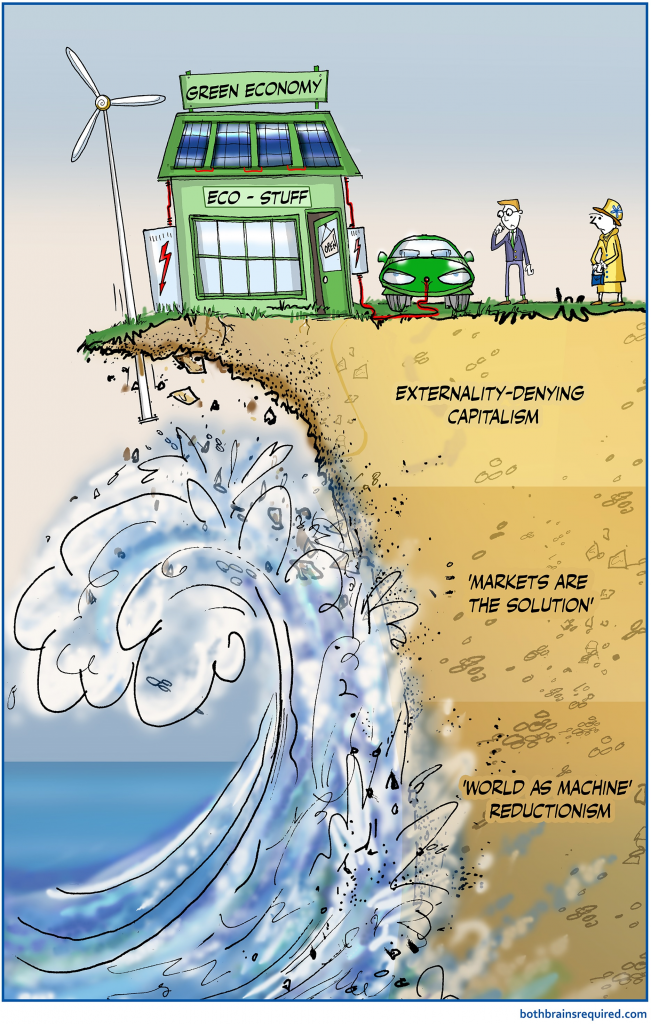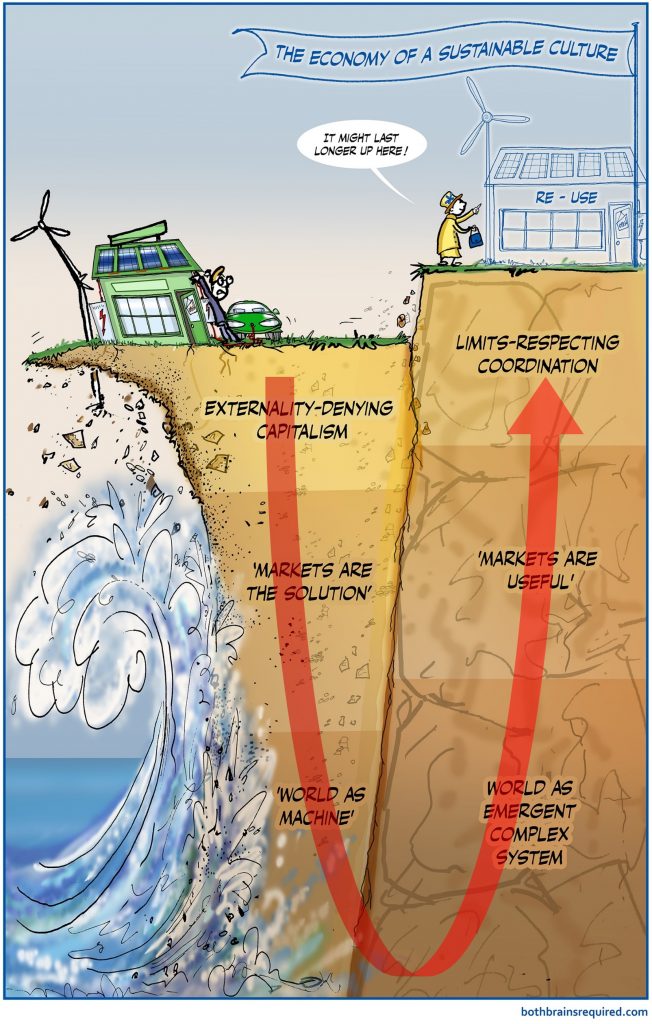…but It May Have Been the Necessary ‘Defence at First Depth’
The story in 12 pictures…

We are a complex system – ‘humankind’ – pitched into adaptive crisis.
Over the last half century, we have suddenly noticed and begun responding to a new sense of our external context. We have abruptly perceived that our surroundings are finite and fragile and that we have attained the numbers and technological capacity to destabilize those surroundings in harmful and irreversible ways.
Our ‘first response’ to this crisis has come to be dominated by Voluntary Market-Led (VML) strategies – CSR, SRI, ESG, ‘impact investing’, divestment campaigns, disclosure frameworks and more.

For all the apparent differentiation, these strategies share the view that voluntary behaviour within existing market frameworks will be sufficient for human culture to become ‘sustainable enough before it is too late.’
Alas, after 25 years, it is becoming clear that the VML meta-strategy is a ‘fix that fails‘. A ‘fix that fails’ is a systems archetype in which a first-order solution triggers a less apparent or delayed, second-order unintended consequence.

Too many of our sustainability ‘solutions’ have rebound and backfire effects, while a discourse ‘fix that fails’ sees enthusiasm for market-led solutions continuing to divert energy, attention and resources from policy and cultural change.
Externality-Denying Capitalism
VML is a ‘fix that fails’ because the underlying ‘fix that fails’ is externality-denying capitalism. We do not call our prevailing system ‘externality-denying capitalism‘, but that is arguably its proper description.

A key driver of our sustainability crisis is that Western culture has not achieved sustained acceptance – distinct from theoretical admission – of the scale of market externalities and what that must imply for claims about the superiority of market-led coordination. Sustained acceptance requires recognizing that the market system has both a ‘fix’ loop and a ‘fail’ loop and taking the fail loop as seriously as the fix loop.
With climate change and the Anthropocene, it is starting to appear as though capitalism’s fail loop is overpowering its fix loop.

In essence, Adam Smith missed an appendage (though it may have been harder to spot in the mid-18th Century). The Market has an Invisible Hand, but it has also always had an Unmentionable Foot. We have celebrated the former, but, well, agreed not to mention the latter.

To clarify, it is not that there is no Invisible Hand – the market’s allocative and innovative dynamics for what is commodified are real and remarkable – only that, in the incompleteness of markets, the market must also have an Unmentionable Foot. The Hand fixes, but the Foot fails us. To believe that economic growth can solve all social and environmental problems is to believe that the Invisible Hand can repair what the Unmentionable Foot damages before irreversible harms occur.

Defending at Greater Depth
Complex systems – such as the complex system called ‘humankind’ – respond to adaptive crises with a layered response strategy called ‘defence in depth’. This is a system working ‘down’ through ‘fixes that fail’ until they find a ‘fix that works’. Adaptive success requires finding a ‘fix that works’ before it is too late.

With Voluntary Market-Led strategies, we are ‘defending at first depth‘ only. (Ignoring the capricious top layer of ‘fashion’ in Stewart Brand’s chart below, VML strategies have been an effort to achieve a sustainable culture primarily through shifting the ‘commerce’ layer).

To accelerate adaptation requires that we shift the powerful gears of governance and culture. As Stewart Brand has expressed it: ‘fast gets all the attention, but slow has all the power.’
Governance and culture are tough gears to get moving, so we need an emergency review of the – entirely pre-Anthropocenic – thinking that is enshrined in our institutions and norms to see whether they make sense in the light of the new day.

Our unsustainability lies much deeper in our cognition than ‘practical’ initiatives and debates yet give any hint of understanding. VML is not a sustainability ‘solution’ so much as the latest presenting symptom of centuries of unsustainable Western cognition.
We are facing a sustainability crisis because our new awareness of the finite and fragile world has not found us prepared – behaviourally, organizationally, even cognitively. We need not surface fixes, but deeper changes in our attitude to – and even perception of – the world. Unfortunately, our ‘surface fixing’ is delaying the deeper reflection needed.

Conclusion
We are a complex system in adaptive crisis.
VML is not so much a solution to the sustainability crisis as a symptom of more profoundly unsustainable foundations of human behaviour. Our first response to the crisis has taken the VML form it has because its market-conforming nature was dictated by centuries of earlier thought and development. Yet, it is in those earlier thought patterns where most of our unsustainability resides.
We had hoped there would be a business case for sustainability. But, after 25 years of leading with a VML meta-strategy, the meta-learning is that there just isn’t much of one. Instead, the moral case for sustainability will have to carry most of the load from here.

While all this is challenging, it may be easier to accept if seen as the sort of meta-learning the complex system of humankind must engage in if we are to adapt before it is too late.
***
For details and references, please see the 60-page paper, “Market-Led Sustainability is a ‘Fix that Fails’… but It May Have Been the Necessary Defence at First Depth”.
Feel free to use any images, if helpful.
Sounds like ethical investing circa 1995. Wilfully and erroneously misread by the mainstream, dismissed as sin stock screens and do-goodism, the powers that be delayed the necessary culture changes by about 30 years. That denial continues today most noticeably in the avarice that characterizes CEO pay supported by most investment institutions, and a topic still fails to arose much ire or concern – or worse, stoutly defended.
Will https://doughnuteconomics.org/ be a solution?
Tragic. Brilliant. We must question All our hopefully blind assumptions. ASAP share widely as I will….
Beautifully articulated and illustrated.
I take some issue with the deep time clockwork though. There are for sure slow natural processes recently in the limelight — our carbon emissions today outlasting civilizations several times over, etc — but there are many quicker ones, for good and bad. Miyawaki afforestation being just one example of manmade syntropic rebound, permafrost melt methane emissions a tipping point.
Same with cultural and tech/market shifts, which are historically slow but increasingly driven by compounding exponentials.
An exception to the otherwise superbly lucid illustrations.
Johan, Thanks for your kind comments. I take your point re. the deep time illustration (originally from Stewart Brand). To be honest, I’d been focused on the human layers above the ‘nature’ base, but your point about there being fast and slow natural processes seems right. Indeed, one might easily draw a set of layers for ‘natural’, non-anthropogenic processes to parallel an anthropogenic set. Thanks again. Duncan
Thank you for permission to use your images, Duncan. This is a very useful and beautiful illustration of how reductionist and piecemeal thinking (and being) have led us to further fragmentation.
This is fantastic. A profound gift. Thank you. The thinking and logic flow is brilliant and the illustrations bring it all together in such a clear way. I will share and use widely in my work, with attribution. Thank you for the permission to do so.
How much is enough?
Go with what works. Vegan is a proven technology. — from the deep woods of the Species’ Forest, Conway, Massachusetts, 501(c)(3) land trust with an ethical vegan board of directors speciesforest.blogspot.com (Richard Stafursky, Vermont)
Good systemic analyses as far as they go…however you omit the most powerful variable: the number of feet. Scale trumps all in a finite system. Humans doubled in my son’s 49 years, tripled in my 76, and quadrupled in my mother’s 97. We are in massive overshoot, and the Maximum Power Principle applies to all living systems. See:
https://www.ecologycenter.us/ecosystem-theory/the-maximum-power-principle.html
In other words, voluntary simplicity is the exception that proves the rule. And there are billions now in INvoluntary simplicity doing all possible to increase their throughput. System design can improve lives to a degree, but it cannot remedy overshoot. Reversal of population growth to a low enough number for a resilient species for the finite habitat is required.